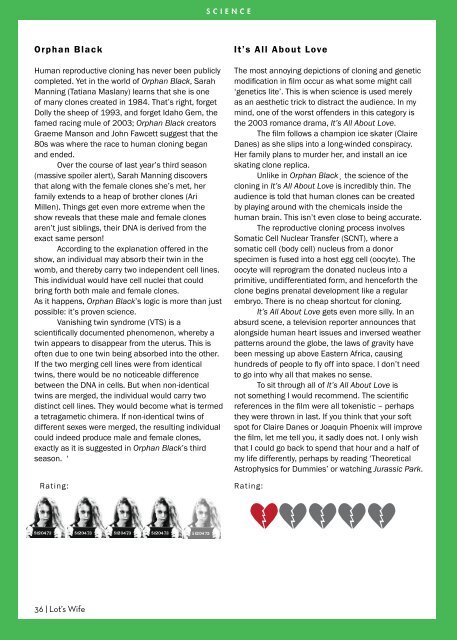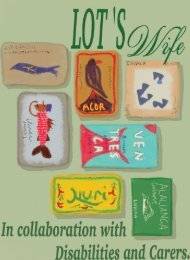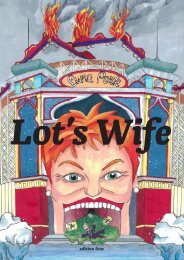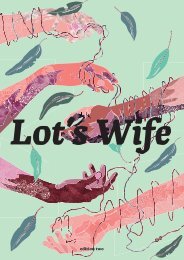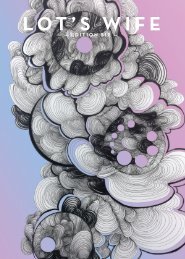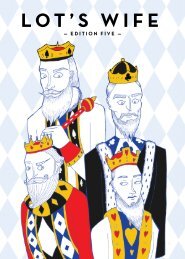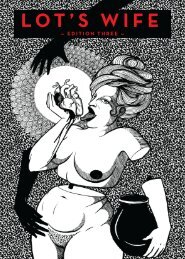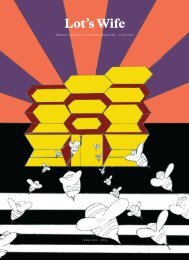Lot's Wife Edition 1 2016
Create successful ePaper yourself
Turn your PDF publications into a flip-book with our unique Google optimized e-Paper software.
SCIENCE<br />
Orphan Black<br />
Human reproductive cloning has never been publicly<br />
completed. Yet in the world of Orphan Black, Sarah<br />
Manning (Tatiana Maslany) learns that she is one<br />
of many clones created in 1984. That’s right, forget<br />
Dolly the sheep of 1993, and forget Idaho Gem, the<br />
famed racing mule of 2003; Orphan Black creators<br />
Graeme Manson and John Fawcett suggest that the<br />
80s was where the race to human cloning began<br />
and ended.<br />
Over the course of last year’s third season<br />
(massive spoiler alert), Sarah Manning discovers<br />
that along with the female clones she’s met, her<br />
family extends to a heap of brother clones (Ari<br />
Millen). Things get even more extreme when the<br />
show reveals that these male and female clones<br />
aren’t just siblings, their DNA is derived from the<br />
exact same person!<br />
According to the explanation offered in the<br />
show, an individual may absorb their twin in the<br />
womb, and thereby carry two independent cell lines.<br />
This individual would have cell nuclei that could<br />
bring forth both male and female clones.<br />
As it happens, Orphan Black’s logic is more than just<br />
possible: it’s proven science.<br />
Vanishing twin syndrome (VTS) is a<br />
scientifically documented phenomenon, whereby a<br />
twin appears to disappear from the uterus. This is<br />
often due to one twin being absorbed into the other.<br />
If the two merging cell lines were from identical<br />
twins, there would be no noticeable difference<br />
between the DNA in cells. But when non-identical<br />
twins are merged, the individual would carry two<br />
distinct cell lines. They would become what is termed<br />
a tetragametic chimera. If non-identical twins of<br />
different sexes were merged, the resulting individual<br />
could indeed produce male and female clones,<br />
exactly as it is suggested in Orphan Black’s third<br />
season. ‘<br />
Rating:<br />
It’s All About Love<br />
The most annoying depictions of cloning and genetic<br />
modification in film occur as what some might call<br />
‘genetics lite’. This is when science is used merely<br />
as an aesthetic trick to distract the audience. In my<br />
mind, one of the worst offenders in this category is<br />
the 2003 romance drama, It’s All About Love.<br />
The film follows a champion ice skater (Claire<br />
Danes) as she slips into a long-winded conspiracy.<br />
Her family plans to murder her, and install an ice<br />
skating clone replica.<br />
Unlike in Orphan Black¸ the science of the<br />
cloning in It’s All About Love is incredibly thin. The<br />
audience is told that human clones can be created<br />
by playing around with the chemicals inside the<br />
human brain. This isn’t even close to being accurate.<br />
The reproductive cloning process involves<br />
Somatic Cell Nuclear Transfer (SCNT), where a<br />
somatic cell (body cell) nucleus from a donor<br />
specimen is fused into a host egg cell (oocyte). The<br />
oocyte will reprogram the donated nucleus into a<br />
primitive, undifferentiated form, and henceforth the<br />
clone begins prenatal development like a regular<br />
embryo. There is no cheap shortcut for cloning.<br />
It’s All About Love gets even more silly. In an<br />
absurd scene, a television reporter announces that<br />
alongside human heart issues and inversed weather<br />
patterns around the globe, the laws of gravity have<br />
been messing up above Eastern Africa, causing<br />
hundreds of people to fly off into space. I don’t need<br />
to go into why all that makes no sense.<br />
To sit through all of It’s All About Love is<br />
not something I would recommend. The scientific<br />
references in the film were all tokenistic – perhaps<br />
they were thrown in last. If you think that your soft<br />
spot for Claire Danes or Joaquin Phoenix will improve<br />
the film, let me tell you, it sadly does not. I only wish<br />
that I could go back to spend that hour and a half of<br />
my life differently, perhaps by reading ‘Theoretical<br />
Astrophysics for Dummies’ or watching Jurassic Park.<br />
Rating:<br />
36 | Lot’s <strong>Wife</strong>


